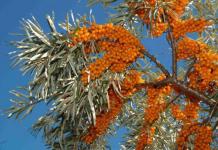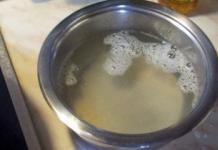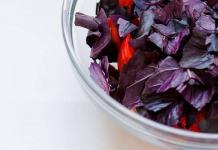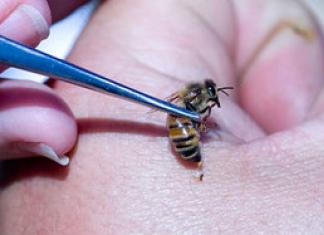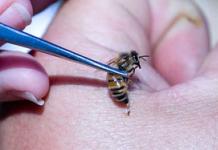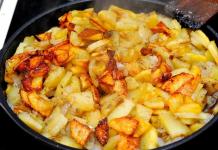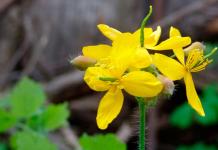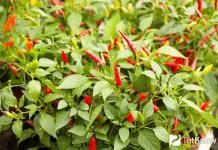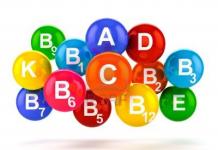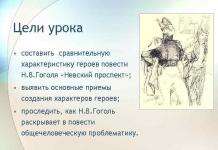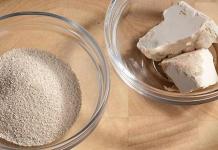Apples are juicy and tasty fruits that are suitable for consumption in fresh, dried, boiled, baked, etc. But the long-awaited harvest can be spoiled various diseases and the pests of these trees.
Diseases
- Affects: whole plant;
- It appears: in the form of a dirty-white bloom, which gradually turns brown and turns into dark spots;
- Promotes: drying and yellowing of foliage, deterioration of the condition of trees, lack of fruit;
- Control: Spraying with chemicals while opening leaves. After dropping the petals, treatment with copper chloride. After harvesting, spraying with copper sulfate or.
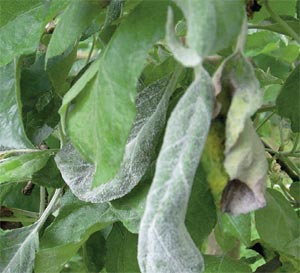
- Affects: bark;
- It manifests itself: as dark ulcers, deepening and increasing in size, which gradually turn into brownish-red ulcers;
- Promotes: the withering away of the bark and the shedding of the bark along with the branches;
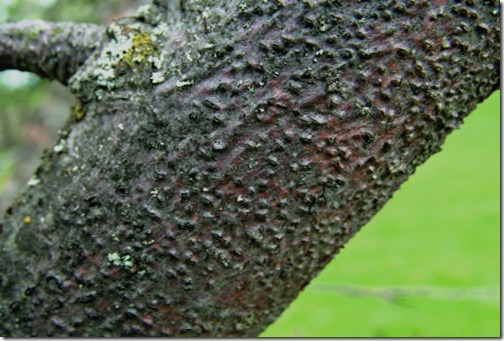
- Struggle: spraying with copper chloride when the buds swell, before flowering, treatment with copper sulfate.
- Affects: fruits and leaves, most often seedlings and young apple trees;
- It manifests itself: in blackening and drying of leaves, spoilage and rot of fruits. However, they do not fall off;
- Contributes to: deterioration of the state of the apple tree, spoilage of the crop, contamination of other trees;
- Control: collection and destruction of damaged leaves and fruits. Disinfection of seedlings, mature trees and soil with copper chloride or copper sulfate.
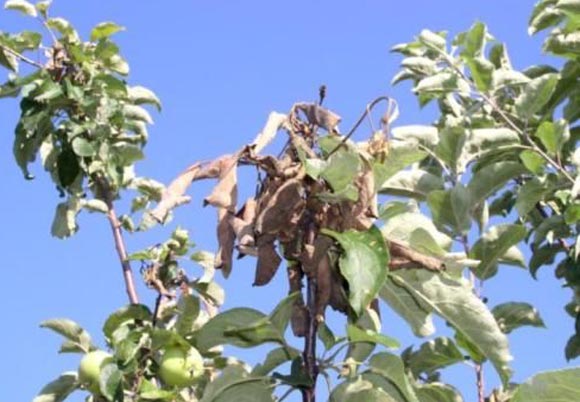
- Affects: flowers, leaves;
- It appears: as a dark brown bloom covering leaves and fruits;
- Promotes: shedding of foliage, slowing down the growth of fruits and deterioration of their taste;
- Fight: Collect and destroy infected leaves and fruits. Trees for prevention must be treated in spring and summer with copper chloride or sulfur.
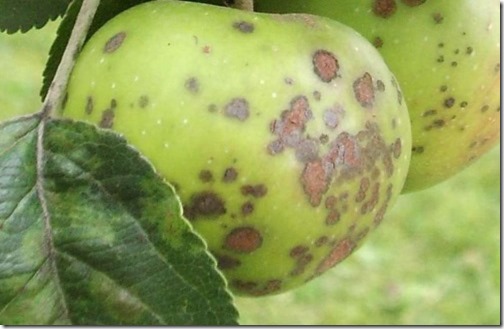
- Affects: trunk and foliage;
- It manifests itself: as air cavities on foliage and their bubbling, whitish-silvery color of leaves, dark spots on the bark and trunk;
- Promotes: falling leaves and branches, tree death;
- Struggle: cut and destroy diseased parts. Disinfect the cut site. As a preventive measure, it is necessary to whitewash the trees in the fall and treat them with special preparations in the spring.
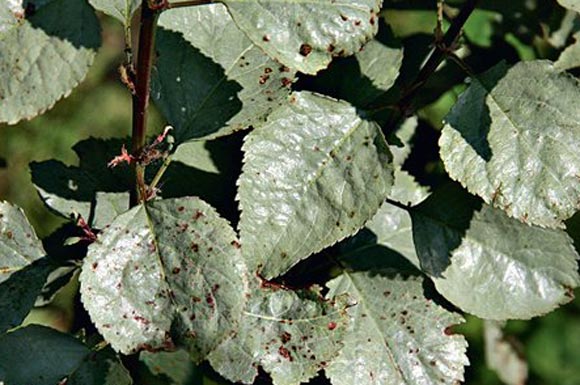
- Affects: foliage, bark, fruits;
- It manifests itself: as dark spots on the leaves, and also provokes fruit rot, tears and cracks in the bark;
- Contributes to: spoilage of the crop, worsens the condition of the tree, can lead to its death;
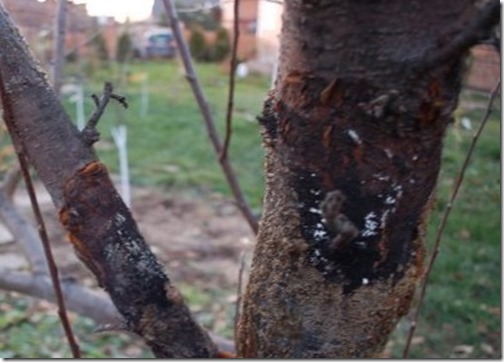
- Fighting: pruning, collecting and destroying infected parts, disinfecting sections. Destruction of pests. Treatment with Bordeaux liquid after flowering.
Pests
- Affects: young shoots and leaves, eating them and covering the tree with a bloom of secretions;
- Promotes: damage to leaves and deterioration of the tree;
- Fighting: ladybugs destroy aphids well, so it is better not to touch them when they appear. Processing apple trees with tobacco decoction and soap solution also helps.

- Affects: leaves, buds;
- Contributes to: destruction of the green part of plants. And also leaves a discharge, which is a favorable environment for the development of microbes and fungi;
- Fighting: fumigation with tobacco, treatment with special preparations.

- Affects: tips of shoots and leaves, sucking out the juice;
- Contributes to: loss of green parts and deterioration of the apple tree condition;
- Struggle: cleansing the apple tree from the old bark in which the tick hibernates. Spraying trees from pests in spring.
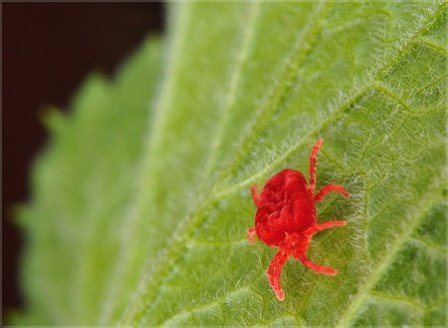
- Affects: leaves that eat moth caterpillars and build spider nests in them;
- Contributes to: destruction of the green part of trees;
- Struggle: Destroy leaves with nesting cobwebs. Processing with special means.

- Affects: fruits, eats away pulp and even seeds;
- Contributes to: deterioration of the quality of the crop and its destruction;
- Struggle: remove and destroy damaged fruits, peel the bark and burn the foliage in the fall, as this is a place for wintering. Processing with special means.

Grow on your own summer cottage a healthy apple tree is always possible, but for this you always need to pay enough attention to caring for it and carrying out at least elementary prophylaxis against pests. If you do not carry it out regularly, then the question of how to treat an apple tree will arise quickly enough. And if you do not start activities on time, then not only can the harvest decrease, but the tree can also die. In the worst cases, the disease spreads to other fruit trees and is capable of infecting almost the entire garden in a short time, causing serious damage to it.
Diseases of apple trees and their treatment
Diseases, most often affecting the trunks of apple trees, appear in cases where there is no proper care for them: the crown does not form, the stem does not whiten, last year's leaves are not removed. After all, the development of even the most serious disease always starts small.
Lichens
Some summer residents still believe that a small lichen on the trunk is even for the best, since it supposedly protects against possible infection with other fungi. However, over time, it will undoubtedly grow, so know that if you do not start the necessary activities in time, then the death of the tree is only a matter of time. Moreover, under the overgrown lichen, scale insects, as well as other pests, may soon appear.
You can eliminate lichen from the apple tree by the following measures:
- Cleaning the trunk from damaged bark using a special device. You can use a stiff brush or a damp stick. It is only important that this procedure be carried out at a time when the tree is at rest and sap flow has already stopped (late autumn, early spring);
- A more reliable method would be to lubricate the affected area with clay, half-mixed with slaked lime in water. After drying on the bark, a mixture of clay is removed with lichen, and the solution penetrates inside and disinfects;
- Additionally, after cleaning, it is better to treat the branches with a solution of oxalic acid, you can also lubricate the place with 3% iron sulfate.
Scab
It manifests itself in spots of brown or olive color, which can be seen not only on the tree, but also on the fruits. Scab can overwinter even in fallen leaves, and then infect fruit. That is why many summer residents burn the leaves in order to prevent the spread of the disease.

It is easy to notice the scab at the initial stage of its appearance - the leaves will be translucent, as if they were dipped in oil. Soon they turn gray, plaque forms, and after that they wither and begin to fall off. At the next stage, the disease affects the fruits, which crack, deform and crumble.
Fungus treatment is carried out by the following methods:
- As a preventive measure, it is required to spray the branches and the soil around with special pesticides before the leaves appear. Copper sulfate, 1% DNOC, nitrafen diluted in 10 liters of water are suitable for this.
- With Bordeaux liquid (3%), the tree is processed at the end of April. You can also replace this agent with copper oxychloride, cuproxant.
- After the buds have flowered, as well as at the stage of their formation, it is also shown to use Bordeaux liquid for spraying, but already at a concentration of 1%.
- A month after flowering, you need to sprinkle the crown and ground. Zineb, phthalan, captan will do.
The most favorable for scab is a thickened garden, as well as old apple trees, so do not abandon caring for them and remove the leaves in a timely manner.
Powdery mildew
Powdery mildew appears even on recently blossoming leaves. Sometimes, after prolonged rains, you can notice a dense bloom on them. white- this will be a sign of illness. It is also fungal, but develops quickly in hot weather. Many do not pay attention to it for a long time, but soon regret it, because in the end it will lead to drying of shoots, inflorescences and leaves, as well as shedding of fruits.
There are several ways to combat powdery mildew:
- It is necessary, first of all, to cut off the affected parts in a timely manner;
- After flowering, the crown is sprayed with Hom;
- When the crop is harvested, processing is carried out with Bordeaux liquid, or copper or iron vitriol;
- In late autumn, the foliage under the tree is harvested and burned.
Cystoporosis
Many people believe that the appearance of resin on fruit is a common occurrence and does not affect them at all. However, this may be the first sign of cytosporosis, another serious fungal disease that causes the branches to dry out. At first, dark ulcers may appear, which become brownish-red as they develop. Cytosporosis spreads quickly, especially if there are favorable conditions for this - waterlogged soil, aridity, lack of nutrition, frost, poor care in general.

How to cure an apple tree in this case?
- After the snow melts and the steady heat returns, carefully monitor the condition of the kidneys. As soon as they swell, you can carry out the first spraying, for example, with the preparation "Hom" (aka copper chloroxide). At the same time, the air temperature should no longer drop less than 15 degrees;
- Before flowering, copper sulfate is already used for processing (50 g of substance per 10 liters of water);
- The third treatment can also be carried out with the Hom suspension. For an adult tree, you need to spend at least 5 liters of solution; for a young seedling, 2 liters will be enough;
- In autumn, you need to ensure good resistance to frost by adding potassium and phosphorus to the soil;
- The whitewashing of the trunk is carried out around November. Skeletal branches also need to be processed. You can additionally repeat this procedure in March.
Fruit rot
This problem appears most often on an apple tree. After all, almost every summer resident was faced with the fact that the fruit rots. It all starts with small brown spots that quickly grow and make apples unsuitable for food. Almost the entire crop is crumbled, although some manage to save a small part of it.

The methods of dealing with rot are quite simple. First, all fruits must be harvested on time, both those that are ripe and those affected by the disease. All fallen and already decaying apples are removed. Copper chloroxide is best for spraying and should be sprayed twice - before and after harvest. Consumption - up to 6 liters per adult tree.
Bacterial burn
It occurs as a result of planting new young seedlings. You can notice it by the fact that the leaves turn black, dry, change shape, the fruits rot and crumble, and some remain on the branches. At the slightest manifestation of symptoms of a bacterial burn, the affected areas must be immediately removed, henceforth disinfecting the tools before pruning and selecting high-quality planting material.
Next, the soil is disinfected: about 60 grams per bucket of water copper sulfate or up to 80 grams of the drug "Hom". For 1 sq. m. at least 2 liters of a diluted solution is poured in. All cuts on the tree after cutting off the affected parts must be either disinfected or oiled with garden varnish.
Milky shine
One of the most serious diseases of apple trees, affecting their trunk and crown, is the milky shine. At first, it appears on the deciduous part, only after penetrating into the wood. Air cavities appear, the plant weakens and gradually dies off.

Since a milky shine appears as a result of a long harsh winter, the most important thing is to prepare the apple tree for wintering. If damage is found to the bark, it must be quickly removed, and the stem will need to be sprayed with any disinfectant. Additionally, you can whitewash it with lime. From the crown, you will need to cut out those branches that are already affected by the milky shine, after which they are burned.
Black cancer
It can also be attributed to the list of the most dangerous diseases for the apple tree. It spreads quickly, affecting branches, leaves, bark, wood. If you do not immediately start treatment or carry it out incorrectly, then you can not only lose the infected tree, but also other fruit that are nearby.

Black cancer is recognized by characteristic spots on the leaves, rot on the fruits. The bark turns black, cracks, turns out. Apple crayfish is also distinguished by the appearance of deep cracks in the trunk, the appearance of growths, drying out of individual parts and gradual dying off.
Timely care is the very first way to avoid the appearance of cancer on a tree. When it appears, it is examined and all affected areas are cut out and burned. Next, you should carry out a thorough treatment with antiseptics. Both copper sulfate and Bordeaux liquid will do. Spray with cuproxate or another drug as a prophylaxis. It is important to pay attention to the surface of the ground around the tree, as various bacteria are likely to remain in it.
How to treat damaged apple bark
The top cover of the tree protects the wood from the effects of many factors, so the bark must also be given due attention. By the fall, it begins to die off and peel off, so it must be cleaned off in a timely manner, and the trunk must be whitewashed with lime to prevent the multiplication of lichens and other fungal diseases. In addition to lime, there are those that are no less effective.
Treatment of wounds that appear on the bark should be carried out in the spring, since before the start of sap flow, they must be overgrown, otherwise the apple tree will be weakened. So, frost holes and other areas exposed to cold weather should be immediately treated with special clay or self-prepared garden pitch. A good putty is obtained by adding a mullein to it - this way you can nourish the tree and give it the strength to heal the wound. Do not coat damaged areas with kerosene, oil, tar and mineral oils!
Cracks should first be cleaned of old bark, and if they appeared from the weight of snow at the fork of two skeletal branches, then after that you need to pull them off with wire, clamps or staples. After that, you can process the newly converged area with clay, diluted in half with a mullein and wrap it with felt or unnecessary cloth in several layers to prevent infection.

If a hollow has arisen on the apple tree, then initially you need to clean everything inside in order to remove the rotten part of the wood to a healthy one and disinfect it with 5% iron sulfate. After that, you need to prepare a wooden sleeve to size, drive it in carefully so that there are no gaps. The next stage is the treatment of the place with garden putty and painting the trunk with a special oil paint. This method is suitable if a small hollow has appeared in the tree, but large ones are closed up in a slightly different way. So, after cleaning and thorough disinfection, you need to dry everything inside a little, fill it with rubble and cement it. This must be done to stop air and water from entering the hole. You can mix cement with sand - this mix is also very good for embedding. The proportions in this case are 1: 6.
In no case do not leave a tree with a hollow unattended, otherwise it will give a small harvest of apples over the next few years, and then it may die or become infected with other serious diseases.
Conclusion
Remember that preventive control measures are always easier and more effective than treating apple trees for various diseases. Spend time with phytosanitary cleaning: cut off excess branches, remove foliage, process the soil and crown in a timely manner, monitor the condition of the bark, lubricate wounds with copper sulfate. Pay attention to watering and fertilizing as well. Carrying out such simple measures, you can be completely sure that you will not need to treat apple trees for diseases.
You can find out more interesting information from the video:
The apple tree deserves care, in gratitude it will provide the owners with delicious fruits that have a large set nutrients... If a good harvest is taken in the fall, then you can be sure that the family will be provided with compotes, preserves, jams for the whole winter.
About signs of disease
The tree immediately reacts to the discomfort that it begins to experience in the event of infection or illness. This condition manifests itself in different types, but it is always obvious, and it is impossible to miss the problems in the health of trees:
1. Yellowing.
The yellow color of the leaves does not surprise anyone when the crop is harvested, as this is the natural state of the flora starting in late August. But some concern should be caused by the yellow color of the leaves.
This means that the disease of the apple tree is progressing and the fight against them must be thought out.
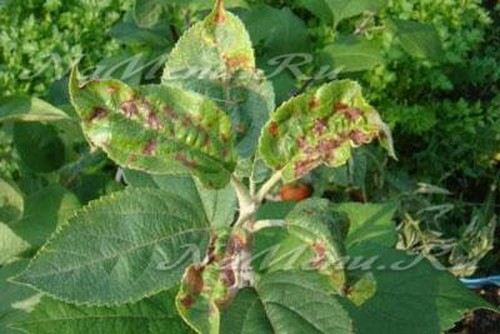
2. Leaf curling is a sign of the presence of aphids.
Blackening of a tree is expressed in the fact that the trunk, leaves, branches gradually turn black. This is a signal about the most dangerous infection with "black cancer" - the disease of apple trees, and the fight against them is urgent. You will also be interested in knowing when to dig up tulips after flowering. You can speed up to get a large harvest of vegetables.
3. Drying of the branches indicates infection with black cancer.
The disease begins with the rhizome, purple stains appear on it, which gradually capture the trunk in a circular manner, heading towards the top of the tree. As the disease worsens, the bark cracks, becoming covered with fungal spores. Dark spots first appear on the fruits, which gradually grow, the fruit dries up. Older trees usually develop cancer, but this suggests that in an earlier period they were not properly cared for.
Similar symptoms are expressed with a tree disease with cytosporosis. It captures weakened trees, as well as those with damaged bark. Cytosporous apples have a brownish-red tint, covered with fungal spores. Such fruits dry out gradually, there is a danger of the death of the entire tree.
What apple trees are sick with
Based on the signs of diseases, it is easy to determine what exactly happened to the tree, to make a diagnosis and begin its systematic treatment. The list of diseases characteristic of apple trees is small, but with improper care, the absence of preventive and therapeutic measures, one can forget that apple trees were once planted on the site.

Cancer.
A. Root - characterized by the appearance of growths on the roots, which are chosen for themselves by harmful bacteria. They appear as a result of the penetration of the roots of the rod bacteria that lives in the soil into the cracks. Root cancer does not develop in winter, but in summer it attacks the tree with renewed vigor.
B. Common - causes a disease of the bark of the apple tree and the fight against them should be started before the start of the season. If the tree is caught in frost in winter, and cracks appear on the bark, then this is a favorable place for the reproduction of fungal spores. The bark in this place dies off, gradually falls off completely.
Treatment: if the tree is severely damaged, there is no point in treating it, it is necessary to cut it down and burn it. If the signs of the disease are focal, then the sections and cracks should be covered with a 1% solution of copper sulfate. On top of this, it is recommended to apply a garden var.
Scab- one of the most common diseases that can affect any type of tree, its leaves, flowers, fruits. Favorable conditions for its occurrence are a humid environment. The scab hibernates safely among fallen leaves. Signs: the appearance of green spots. They manifest themselves with a disease of the leaves of the apple tree, the fight against them photo will be effective if it is not postponed until later.

Over time, the spots darken, become brown. The whole tree is gradually affected by the action of the scab, it deforms and cracks. Treatment is carried out with Bordeaux liquid. It effectively affects the scab if you spray it on the apple tree and the soil under it. This should be done during bud break.
If this period is missed, then the procedure can be carried out during the formation of buds. Only the solution should be more gentle - 1%. It is recommended to arrange the next stage of treatment immediately after the end of flowering, then after 2-3 weeks - another one.
In the fall, be sure to take care not to leave fallen leaves under the trees. The soil within a radius of 70 cm around the trunk must be dug up. You can grow cucumber seedlings in 5 liter bottles.
Brown spotting.
The indicator of the disease is brown spots on the leaves. The infection appears in early summer, is fungal in nature, and develops at an incredibly fast pace. The treatment methods are similar to how the process takes place with a scab disease.

Powdery mildew.
A common disease of all fruit trees: apple and pear disease, the fight against them in the photo means that it will not spread from one tree to another. Dew captures bark, buds, leaves. A loose bloom of a whitish shade appears on them, then it gradually darkens. The disease dries up the tree, as a result, it ceases to bear fruit.
Treatment: at the time of leaf blooming, a 1% Bordeaux solution is suitable for spraying. After the end of flowering, it is necessary to re-sprinkle the trees with copper oxychloride. To obtain a large harvest, you can accelerate the ripening of tomatoes.
Insects - pests of apple crops
There is a battle for the apple trees throughout the summer. They are susceptible to infections and also attract various insects, as a result of which diseases and pests of the apple tree arise and the fight against them is in the power of summer residents, if you approach responsibly the fate of your future harvest.
Aphid.
Apple green aphid is the most common pest for apple trees. It can settle on trees in huge colonies. Aphids eat and spoil the leaves, leaving behind harmful waste products.
Treatment: in the fight against aphids, a 3% solution of karbofos is used, which needs to be treated with a tree in the spring. It can be processed later, when the kidneys appear, but during this period the concentration of the solution should be 2%. A good natural assistant in the fight is the ladybug. For her bait, chamomile, tansy, dandelions, coltsfoot can be planted on the site.
Caterpillars.
Treatment: caterpillars form spider webs, which must be collected and incinerated upon first sighting. Karbofos will help kill insects if you apply its 2% solution during kidney formation.

Mole.
Caterpillars, which appear in spring, eat up the buds, then move on to young leaves. Gradually creating a spider dome, the moth gathers under it as a whole colony.
Treatment: wood processing with 7% chlorophos solution, 2% ash solution of your choice. Spraying is carried out in the spring after the appearance of the buds.
The mite is red.
The mite larvae hibernate at the base of the shoots in the cracks in the bark, then get to the leaves and accumulate there in whole colonies. During the season, they produce up to 6 generations of their own kind, which live on stems and leaves.
Treatment: treatment with nitrophen before the appearance of buds, during the budding period and after flowering with karbofos, colloidal sulfur, phosphamide, with a gradual decrease in the concentration of the solution. The last spraying should be carried out no later than a month before harvesting.
Ants
These insects are a real disaster for gardeners. They not only harm trees themselves, but also lure aphids. The ants themselves appear in the spring, gnaw at the buds, preventing them from ripening.
Treating trees for these insects is better called. It must become radical, because they will never leave of their own accord, but only multiply. Fighting with chemicals is ineffective, since in small quantities they will not help, and in large doses they can kill bees. Therefore, it is recommended to use traps with poison inside. It is enough for one ant to hit it, it will infect all its fellows. More humane measures for the destruction of ants have not yet been invented.
Silkworm
The silkworm specializes in eating leaves. One caterpillar can kill 35,000 of them. Egg-laying is not difficult to find, as it is concentrated on the leaves. The best way to avoid the appearance of silkworm eggs is treatment with a solution of karbofos before flowering.

Leaf roll.
Caterpillars of green color appear in the spring and begin to devour the buds, flower buds, along the way, creating a cobweb. By the middle of summer, having eaten enough, the caterpillars pupate. It is difficult to spot the leaf rollers as they blend in color with the foliage. For prevention, it is recommended to spray the apple trees in advance, before the appearance of buds, with a 3% nitrafen solution.
Moth
The moth moth hibernates in the soil or bark in a dense cocoon. At the end of flowering, butterflies appear, which lay eggs, from which caterpillars reappear. They break through real tunnels in fruits and even shoots. This causes the trees to dry out and die. In the fight against this pest, spraying with chlorophos is used.
In addition to all means of controlling pests of apple trees, it is necessary to increase their immunity. This is achieved by feeding and fertilizing them and giving them their own strength in the fight against infection and insects.
There are no plants and trees that never get sick. The apple tree is no exception. This fruit tree needs care. It consists in grafting, pruning damaged branches and, of course, preventing many diseases and pests. In order for your apple orchard to be healthy, you need to know about the ailments of the plant and how to treat them.
Apple tree diseases: black cancer
Apple tree cancer manifests itself visually. The cause of its occurrence can be both the climatic factor and improper and insufficient care of the tree. There are several forms of the disease.
So common cancer proceeds in apple trees and other fruit trees in the same way. Thickening appears on the trunks and crown. Bark damage and decay are possible. In apple trees, this cancer usually appears as open or closed lesions. In the 1st case, depressions are formed on the trunk, in the 2nd - growths. All these wounds do not heal or disappear. A reddish border and additional growths are formed around them.
The cause of the disease is low temperatures... They contribute to the easier penetration of fungal spores into the crowns, since cracks form on the trunks due to frost. When the first symptoms appear, the damage is lubricated with garden varnish or Bordeaux liquid. Further, all damaged branches are cut off and burned away from the garden trees. This disease should not be confused with the consequence of sunburn.

Visually, this disease resembles the consequences of a fire. The trunk looks charred. The black bark of the apple tree is overgrown with growths in which the spores of the fungus are located. Cancer affects not only the bark, but also the leaves with fruits. The fact is that it usually develops during the harvest season or after it, when apples are stored in cellars.
On the leaves, black apple crayfish manifests itself as follows: light spots are formed. Then dark dots appear in their center. The leaves dry out and fall off. Fruits can also shrink and fall off. To prevent illness, wounds must be disinfected in a timely manner. It is also believed that vigorous and frost-resistant apple trees are more resistant to the disease.
Diseases of the apple tree: photo
The most common diseases of apple trees include powdery mildew, scab, fruit rot, table rot. Each of them has its own special symptoms and course.
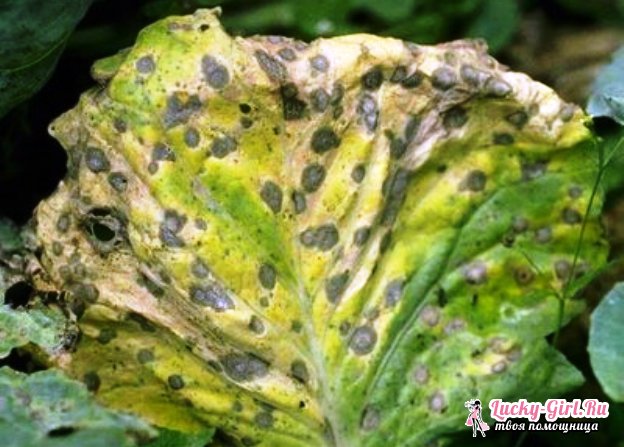
Cytosporosis affects trees of different ages... At the same time, apple trees that have recovered and weakened are most susceptible to this disease. First of all, you should pay attention to the bark. Visible spots appear on it, while they do not darken, but remain brownish. If you try to remove such a section of the bark, then it will lag behind the trunk in pieces, as if peeling off.
The bark dries out gradually, the whole tree can dry out completely. This is due to the fact that the disease penetrates into the tree. There are several ways to deal with the disease. Among them is the use of fungicides. Sick branches must be cut and destroyed. Prevention of cytosporosis is also necessary. To do this, you need to increase the immunity of apple trees.
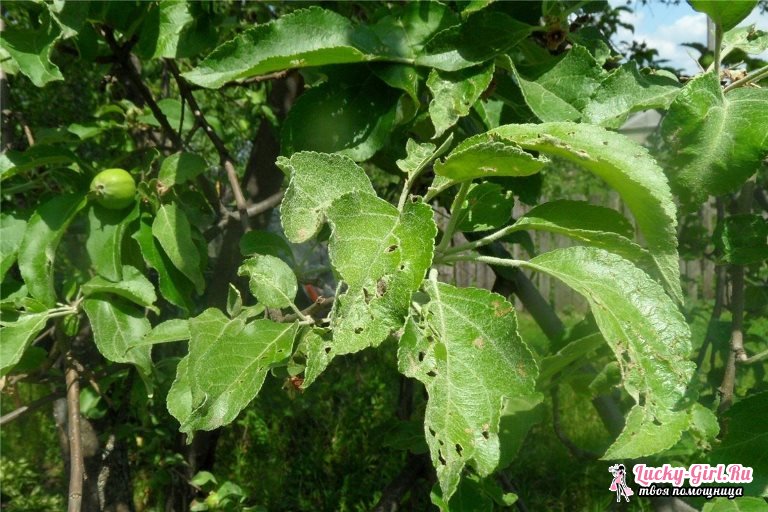
Due to powdery mildew, a white or gray bloom appears on the leaves and ovaries. Gradually it changes color to brownish. The tree at this time begins to literally deplete. This is manifested in the drying out and falling off of leaves and shoots. Also, the apple tree stops bearing fruit. For these symptoms, you need to find the right treatment.
For this, various drugs are used. Dissolve 2 ml in 1 bucket of water. "Topaz" or "Skora". Then the resulting liquid is sprayed with a sick apple tree. After harvesting, the trees can be treated with Bordeaux liquid.
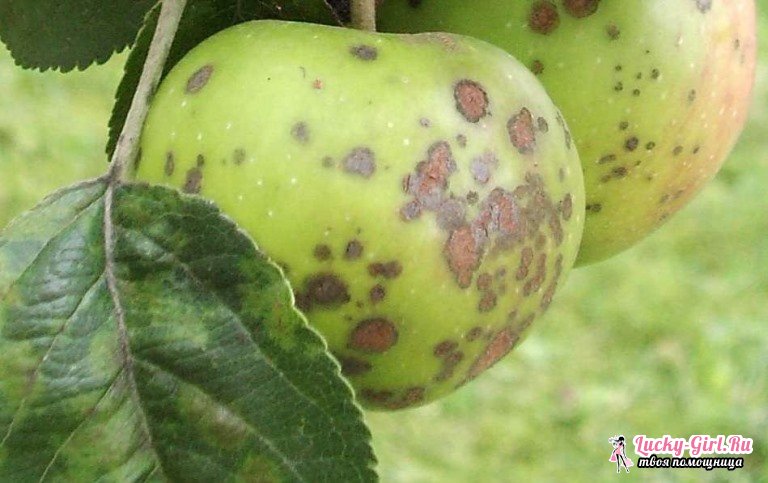
Fruit rot is not a disease, but rather a consequence of the disease. It proceeds as follows: the fruits begin to rot. In this case, the crown, leaves, branches seem to be absolutely normal. All fruits must be removed and destroyed away from trees. Apples can be burned.
Fight against diseases of apple trees consists in timely care and treatment. In early spring, all diseased branches should be cut off with a solution of copper sulfate and the cuts should be covered with garden pitch. The whole tree is sprayed with Bordeaux liquid. After flowering, apple trees are treated with stimulating solutions that affect the formation of fruits. Then they are sprayed with drugs against pests.
Diseases and pests of the apple tree: how to treat?

Another apple disease is scab. It spreads through controversy. In the fall, the infected leaves fall off, and in the spring you can see dark tubercles with spores on them. Further, the infection of young leaves occurs. The situation gets worse with high humidity and heat. Due to these factors, spores in the leaves germinate and form a mycelium.
As follows from the description of the disease, symptoms appear first on the leaves. Light yellowish spots appear on them. Sometimes they have an oily sheen. It all ends with the leaves drying out. The disease spreads to buds, ovaries and mature fruits.

You can deal with scab in different ways. One way is to sprinkle with urea in the fall. While the buds are in full bloom, the apple trees can be treated with Bordeaux liquid. As a preventive measure, all fallen leaves in the fall should be burned.
Powdery mildew is a fungal disease. A velvety whitish bloom appears on the leaves and ovaries. Further, the deformation of the leaves begins. They curl into a tube, bending the edges up so that you can see the underside of the sheet. White bloom also goes to the ovary. Damp warm weather contributes to the development of the disease. The result of the disease is considered to be a decrease in the winter hardiness of apple trees and a huge decrease in yield.
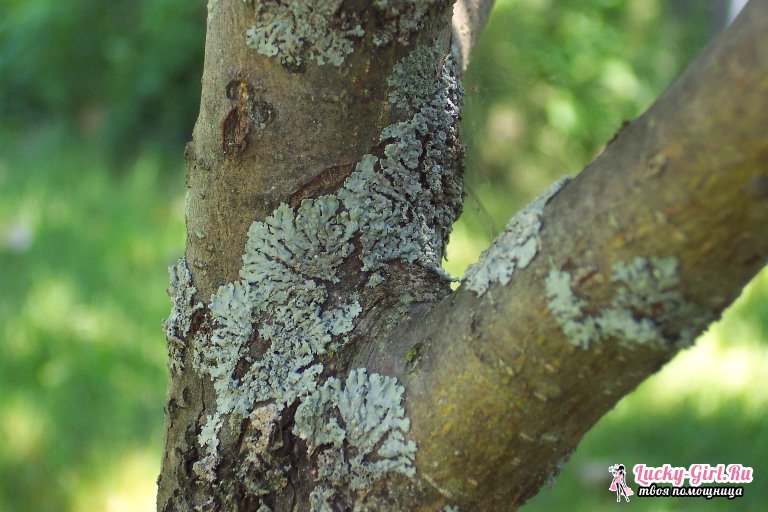
Prevention is the destruction of diseased areas, timely watering, and preventing overdrying of the soil. By the way, a number of drugs can be used for a whole range of diseases. Against the scab, "Vectra", "Skor", Bordeaux liquid, "Kuproksat", "Cumulus" are used. Copper sulfate is used for a combination of various diseases and for disinfection of wounds. Stora, Thiokvit and colloidal sulfur are used against mildew.
When the first symptoms of the disease occur in apple trees, it is necessary to understand what was the causative agent. In accordance with the symptoms, drugs and a method of treatment are selected. In order for the apple tree to be healthy, a number of preventive measures must be followed. It is necessary to destroy diseased branches and leaves after harvesting, disinfect wounds. Also, knowledge of the symptoms of some diseases will help to understand in a timely manner why the leaves of the apple tree turn yellow, why spots appear on the bark and fruits.
Everything fruit trees exposed to a variety of diseases, pest infestations. A responsible, competent gardener who looks after his garden must be aware of all the dangers lurking around the apple tree. Knowing the main symptoms, manifestations, you can diagnose the most dangerous ailment in time, start professional treatment.
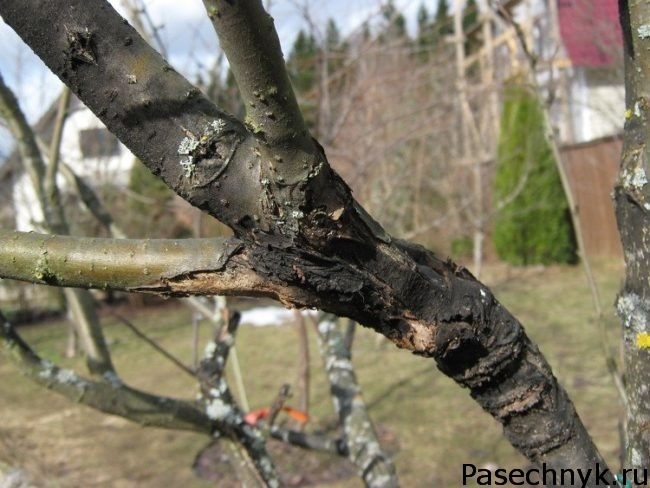
Apple disease is a violation of the normal life of the tree, resulting from the influence of a pathogenic factor. As for the agrotechnical factor and weather conditions, they cause non-infectious ailments that can become the first stage in the formation of viral, fungal, and also bacterial invasion.
Non-communicable diseases:
- frosty sunburn;
- accretion of fruits, flowers;
- chlorosis;
- small-leaved, rosette;
- vitreous fruit.
Diseases of a non-infectious nature are perfectly eliminated by active influence on the pathogenic factor:
- protective measures against frost;
- introduction of microelements, fertilizers;
- sanitary, preventive pruning.
Reliable protection of the tree is the key to it healthy development, fruiting. The disease of apple trees, provoked by pathogenic substances that have penetrated the structure of the tree, is called infectious. Infection occurs when the bark is damaged by water or sucking insects.
Fungal ailments or mycoses - the defeat is carried out due to spore pathogens, phytopathogenic microorganisms that form conidia, mycelium in the body of the plant.
The most common mycoses among apple trees are:
- scab;
- common cancer;
- root cancer;
- black cancer;
- milky shine;
- rust;
- fruit rot (moniliosis);
- lichen and tinder fungi;
- brown spot (phyllosticosis).
As for the bacterial disease, the pathogen is represented by a unicellular organism, its lesions are called bacteriosis. Such diseases include:
- bacterial burn;
- bacteriosis.
- mosaic disease;
- flattening of branches;
- proliferation.
In order to start fighting the disease, it is important to become familiar with the visual symptoms of the most common problems. Signs:
1) Changing branches:
- the presence of unnatural curvature, flattening of the branches - furrowing of the bark;
- shoots bend in the form of a whip - bacterial burn.
2) Transformation of the epidermis:
- peculiar growths appear that look like a mushroom with a hat - tinder fungus;
- the color of the bark turns reddish-brown, it cannot be peeled off - the presence of cytoporosis;
- plaque lamellar silvery shade - lichen;
- the bark cracks - the cancer is black, the burn is frosty and sunny;
- the formation of thickenings that transform into ugly growths - common cancer.
3) Changes in apple leaves:
- yellow spots appear - chlorosis;
- blackening of foliage - bacterial burn, scab;
- the presence of a milky shade in the leaves - milky shine;
- brown spots - moniliosis, black cancer;
- the skin of the epidermis becomes transparent - phyllosticosis;
- the shape of the leaf is changing - small-leaved;
- black blotches with orange on the leaves - the presence of rust;
- too early leaf fall - indicates the appearance of proliferation, mosaic disease and rust;
- foliage falls, curls up - powdery mildew.
4) Fruit transformation:
- apples fall off too early - moniliosis, chlorosis;
- fruit mummification is observed - black cancer, moniliosis;
- cracking occurs, one-sidedness of the fruit - scab;
- apples become transparent - the fruits have vitreousness;
- fruits harden, lose consumer qualities - scab;
- the taste of the fruit is lost, the apples become very soft - fruit rot.
5) Disruptions at the time of flowering apple trees:
- flowers dry up after they turn brown - bacterial burn, black cancer;
- flowers fall off until the ovary appears - powdery mildew;
- accretion of flowers in a bud - accretion;
- shedding of the ovary - scab, small-leaved, rosette.
As you can see, in almost any disease, damage to the bark, fruits is observed, spots of different colors appear on the leaves, for example: brown, orange, red and others. Learn how to deal with major diseases so that when signs are found, treatment of the tree can be started in a timely manner.
Therapeutic technique
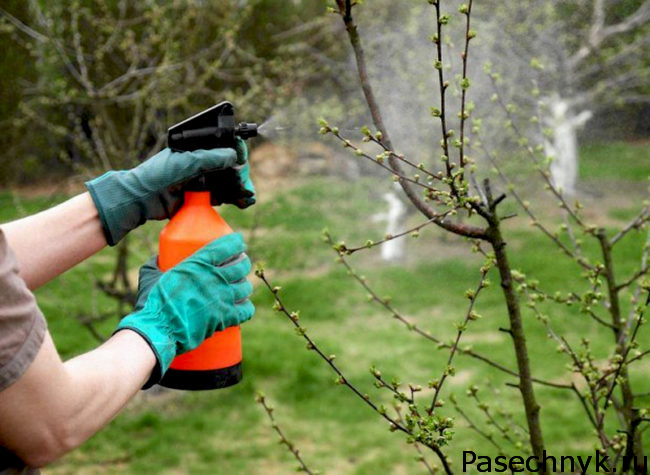
Diseases of apple trees and their treatment is a purely individual process, since everything depends on the stage of the disease, the form, and the severity. Given the description of apple diseases, the most severe and dangerous is black cancer, which is rarely treatable. More often than not, a positive result is impossible. The cause of development is considered to be cold, heat. Cancer is capable of causing various injuries that have been suffered by a tree. If there was no special treatment, then the infection has occurred. The neglected stage is fraught with the death of the tree.
Cancer is treated as follows:
- get rid of infected branches, the bark is cut around the cut;
- with the help of antiseptic preparations, they perform high-quality processing of the apple tree. Given that the disease can be on the leaves, they are treated with Bordeaux liquid;
- open wounds are lubricated with an appropriate agent - garden variet. It is impossible that it contains drying oil, rosin.
If you start to heal the apple tree on time, there is a chance to save the fruit tree.
The next common ailment among apple trees is powdery mildew. Affected areas: buds, foliage, bark, and also shoots. Outwardly, it looks like a dirty coating, which becomes brown; in some situations, dots of a dark color are formed. The foliage turns yellow, dries up, the strength of the tree withers, the development and growth of shoots stops, there is no harvest. If the disease is not recognized in time, then in the spring it will gain new strength, and the fight will become ineffective.
Treatment is carried out as follows:
- therapy begins in the spring, after the young leaves bloom;
- then the plant is sprayed using the appropriate drug - Topaz, Skor. You will need two milliliters of product for 10 liters of water;
- after flowering, the tree is treated with copper oxychloride, you can use Hom. Forty grams of the product is taken for 10 liters;
- after harvesting, Bordeaux liquid 1% or a special solution of copper sulfate is used. For one bucket of water, take fifty grams of vitriol, twenty milliliters of liquid soap.
With cytosporosis, extensive damage to the bark of the apple tree is observed. The cause of the disease is improper watering, poor and heavy soil. The defeat occurs among weakened specimens in which the integrity of the cortex is damaged. The main symptom is that spots and dark ulcers form on the trunks and branches, which progress over time, increasing in size. If there is no timely help, the apple tree will not be able to survive. The fight against the disease will be successful if you start it at an early stage. Treatment is the same as for powdery mildew. Before the onset of winter, potash, phosphorus fertilization is applied.
If the apple tree is affected by a milky sheen, then a special whitewashing of the trunk, skeletal branches will help. It is performed twice a season - in the fall, at the end winter period... For this purpose, milk of lime 20% is used. Two kilograms of milk are diluted in 10 liters of water. 500 grams of five percent copper sulfate is added to the resulting mixture.
A bacterial burn affects young, mature fruit plants. The reason for the appearance is warm rain, high air temperature. As a result, the apple tree loses its flowers. The main symptom is black spots appear all over the tree. If shoots, branches are affected, watery dark spots appear on them. The foliage has a burnt appearance, it is bent.
In addition to diseases, special pests damage the apple tree. It should be noted that they need to be dealt with in a timely manner in order to avoid sad consequences.
Varieties of apple pests
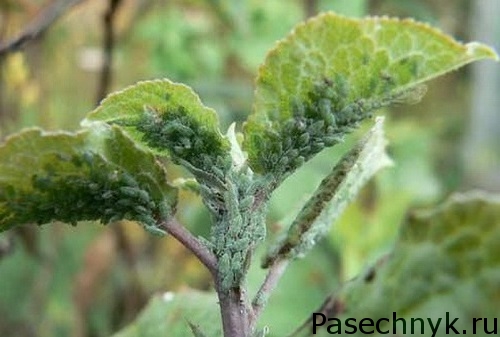
Pests can greatly harm the garden, causing different diseases... They must be properly dealt with in order to prevent their spread throughout the garden. It is important to recognize pests in time in order to achieve a positive outcome. It is advisable to carry out prophylactic spraying of apple trees every spring, this will provide strong protection against all kinds of pests. Correct, competent fight against them is the key to successful treatment.
There are a huge number of ailments and pests that harm apple trees. There is a defeat, rotting of whole trees, foliage, fruits, shoots. Proper protection of the apple tree from such misfortunes is important. Be sure to carry out agrotechnical tree care, do not forget about preventive measures, and your garden will become well-groomed, healthy and fertile.




